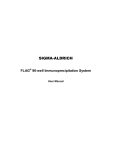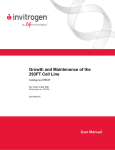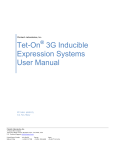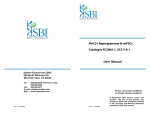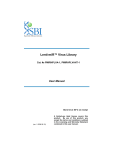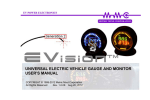Download mirPS® Liposomal Kit User Manual
Transcript
For laboratory research use ONLY. Not for therapy or diagnostics. Not for Resale. mirPS® Liposomal Kit User Manual Catalog Numbers: M-125-302-CM M-126-302-CM M-127-302-CM M-128-302-CM Stable for six months when stored at 4°C Introduction References 1. 2. 3. 4. 5. 6. 7. cPP cPPT Lin et al., (2008) MiR-302 reprograms human skin cancer cells into a pluripotent ES-cell-like state. RNA, 14: 2115–2124. Lin et al., (2010) MicroRNA miR-302 inhibits the tumorigenecity of human pluripotent stem cells by coordinate suppression of CDK2 and CDK4/6 cell cycle pathways. Cancer Res., 70: 9473-9482. Lin et al., (2011) Regulation of somatic cell reprogramming through inducible mir-302 expression. Nucleic Acids Res., 39: 1054-1065. Moyoshi et al., (2011) Reprogramming of mouse and human cells to pluripotent using mature microRNAs. Cell Stem Cell, Vol 8: 633-638. Anokye-Danso et al., (2011) Highly efficient miRNA-mediated reprogramming of mouse and human somatic cells to pluripotency. Cell Stem Cell, 8: 376388. Subramanyam et al., (2011) Multiple targets of miR-302 and miR-372 promote reprogramming of human fibroblasts to induced pluripotent stem cells. Nat. Biotech, 29: 443-448. Card et al., (2008) Oct4/Sox2-regulated miR-302 targets cyclin D1 in human embryonic stem cells. Mol. Cell Biol. 28: 6426–6438. PCMV miR-302 or miR-302/367 RRE GFP Ψ SV40 polyA 5' LTR pMir302-GFP pUC ori 4q25 Notice to Purchaser CAREFULLY READ THE FOLLOWING TERMS AND CONDITIONS BEFORE OPENING THIS KIT. OPENING THIS PACKAGE INDICATES YOUR ACCEPTANCE OF THESE TERMS AND CONDITIONS. IF YOU DO NOT AGREE WITH THEM, YOU SHOULD PROMPTLY RETURN THE PACKAGE UNOPENED AND YOUR MONEY WILL BE REFUNDED. 3' LTR Ampr r 1. 2. 3. Puro Upon using this kit, the users agree to the terms of the Notice to Purchaser and government regulations. All usage of this kit is subject to the US and PCT patent laws. This kit is to not be used for human cloning or generation of hybrids. mirPS® mir-302 Transfection Kits and mirPS® mir-302/367 Transfection Kits (mirPS® Kits) are covered under a series of international patents and patents pending. Rights to use these products are limited to research only. They are not to be used for any other purpose, including, but not limited to, use in drugs, use in diagnostic, use in therapeutics, or in use for human cloning or generation of hybrids. This limitation expressly excludes the right to resell or otherwise transfer the mirPS® Kits or its component parts to third parties. These products may not be modified for resale, or used to manufacture commercial products or to provide a service to third parties without written approval in advance from Mello Biotech. Notwithstanding the above, academic and not-for profit research institutions whose research using the mirPS® Kits is sponsored by for-profit organizations, which shall receive ownership to data and results stemming from the sponsored research, shall need a separate commercial license agreement from Mello Biotech in order to use the mirPS® Kits. Inquiry into the availability of a license for commercial or therapeutic purposes, please contact a licensing representative by phone at (562)946-0131 or by e-mail at [email protected]. mirPS® is a registered trademark of Mello Biotechnology, Inc. Mello Biotech logo and trademarks are the property of Mello Biotechnology, Inc. Copyright 2009 © by Mello Biotechnology, Inc. PEF1α Figure 1 The miR-302 Liposomal Expression Kit is designed for intracellular delivery and expression of the miR-302 microRNA family (miR-302b, c, a and d pre-microRNA cluster, with or without miR-367). As shown in Figure 1, expression of the miR-302 premicroRNA is cytomegalo virus (CMV) promoter-driven and directly linked to GFP expression, allowing easy identification of transfected cells. In addition, the plasmid includes a puromycin resistance gene for selection of target cells. The miR-302 family is expressed most abundantly in early human embryonic stem (hES) cells and quickly decreases after cells differentiate. Transgenic delivery of miR-302s into human skin, hair follicle and kidney epithelial cells, as well as prostate cancer, breast cancer, liver cancer, and melanoma cells has been shown to orchestrate the reprogramming of somatic cells to induced pluripotent stem (iPS)-like cells (References 1, 2 and 3). The miR-302-reprogrammed iPS cells, namely mirPS cells, not only express many key hES cell markers, such as Oct4, Sox2 and Nanog, but also have a highly demethylated genome similar to hES cells. Microarray analyses revealed that genome-wide gene expression patterns between the mirPS and hES H1 and H9 cells share over 86%–92% similarity. Under molecular guidance in vitro, these mirPS cells can differentiate into many distinct tissue cell types derived from all three germ layers. Therefore, miR-302 can replace Oct4, Sox2 and Nanog for simpler and more efficient generation of iPS cell lines. D-125-302-PR [email protected] TEL: (562) 946-0131 FAX: (562) 645-5332 For laboratory research use ONLY. Not for therapy or diagnostics. Not for Resale. Liposomal Kit How can I improve the transfection efficiency? GFP should be observed within 1~2 days after transfection. Some cells are difficult to transfect and may require multiple transfections. Low transfection efficiency may be the result of multiple factors including: Inappropriate cell density at the time of transfection Inadequate incubation time for the transfection complex Poor cell condition/old cells If you are experiencing problems with liposomal transfection, try increasing or decreasing the amount of transfection complex used per reaction. Mello Biotech also offers an electroporation kit, which may work better with some cell lines. For delivery of miR-302 (only) or miR-302/367 into mammalian cells. Included in this kit: miR-302 or miR-302/367 Plasmid Control Plasmid Transfection Reagent Additional Equipment and Reagents Required: Mammalian cells with appropriate culture medium Collagenase I / trypsin-EDTA solution (4 : 1) (optional) Cell culture incubator at 37C under 5% CO2 Tissue culture dishes Feeder-Free Culture Medium (M-800-011) 1 mg/mL puromycin stock PROTOCOL What is the morphology of a miR-302-induced pluripotent stem cell? The iPSCs are spherical cells with loose nuclei and are surrounded by abundant cytoplasm. Step 1—Cell Preparation: 1. Seed appropriate number of mammalian cells onto a 100-mm tissue culture dish. The number of cells required varies with cell type. For best results, wait until cells have adhered to the plate’s surface and are about 40-60% confluent on the day of transfection. 2. One hour prior to transfection, replace the cell culture medium with 10 ml of fresh serum-free/antibiotic-free medium. I have initial high transfection efficiency, but very few iPSC colonies. How can I increase the reprogramming efficiency? Reprogramming is largely dependent on cell type and concentration of miR-302 (Lin et al., NAR 2011). Make sure puromycin selection is performed. Wait 3~4 days after Puromycin selection before transferring colonies to Feeder-Free Medium. If you switch cells to Feeder-Free Medium too soon, cells may detach and form aggregates which may reduce iPSC survival. We recommend culturing iPSC colonies under feeder-containing conditions to improve reprogramming efficiency. Step 2—Transfection: 1. Into a sterile 1.5 mL microcentrifuge tube, add 15 L of miR-302 Plasmid or Control Plasmid. 2. Add 1 mL of serum-free/antibiotic-free medium and mix well by vortexing. Spin tube briefly. 3. Add 50 L of Transfection Reagent (#3) to the center of the 1.5 mL microtube. Add directly into the liquid in the tube. Do not pipette the transfection reagent onto the sides of the tube! 4. Vortex for at least 30 seconds. For best results when preparing more than one transfection complex at the same time, be sure to mix each tube immediately after adding the transfection reagent. 5. Incubate for 10-15 minutes at room temperature. (The transfection mixture can be incubated for longer at room temperature, but do not exceed 30 minutes). 6. Add the mixture drop-wise, covering the entire surface of the 100-mm culture dish. Mix by shaking the culture dish back-and-forth and right-to-left several times to evenly distribute the transfection mixture. 7. Incubate the cells at 37C under 5% CO2 for 12~18 hours and then replace the medium with FBS containing growth medium. 8. Continue to grow the cells at 37C under 5% CO2 until the green-positive cells can be observed under a fluorescent microscope. GFP expression is typically observed1~2 days post-transfection. The results may vary with different cell types. How can I isolate an iPSC colony to produce a cell line? A two- to eight-cell stage iPSC colony is the best choice to isolate for the formation of a single iPSC line. Cell isolation can be performed under an inverted microscope using a micromanipulator in conjunction with a micro-injector/holder. Alternatively, you can select colonies with pipette and very sharp eyes. Fluorescence activated cell sorting (FACS) can also be used to isolate iPSC colonies. How do I ensure the quality of miR-302 plasmid? Store the kit at -80°C freezer to maintain its quality. The plasmid is stable for one year under this condition. Avoid repeated freeze-thaw cycles of the plasmid. Due to the structural complexity of the miR-302 cluster, amplification of the plasmid may cause mutations. If you would like to sequence the plasmid to insure its quality, please contact Mello Biotech for primer information. Refer to the FAQ section of our website (http://www.mellobiotech.com/faq.html) and Lin et.al. (2011) Nucleic Acids Research 39: 1054-1065 for additional information on miR-302/367 reprogramming. Step 3—Selection of Positive Cells: 1. Once GFP expression has been observed, puromycin selection may be used to remove any non-transfected cells. Treat cells with 50-100 ug/mL puromycin for 24-48 hours. Observe cells; if a large percentage of nontransfected cells remain, increase the puromycin concentration and treat for and additional 24-48 hours or until population is relatively pure. 2. Once iPSC colonies are larger, select colonies (either manually with a pipette or with a micromanipulator) and transfer them to a new tissue culture dish containing Feeder-Free Culture Medium (Mello Bio cat. no. M-800011). Allow colonies to grow to desired size. Troubleshooting Does the miR-302/367 plasmid integrate into the genome? Integration depends on the delivery methods. Liposomal transfection is transient in nature, and it should not integrate into the genome. Transfection by electroporation should not cause integration. However, under conditions of high voltage or long duration, some integration (<10%) may occur. Lentiviral infection leads to integration. D-125-302-PR [email protected] TEL: (562) 946-0131 FAX: (562) 645-5332


